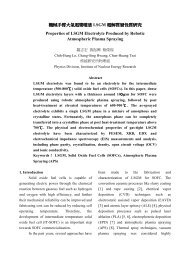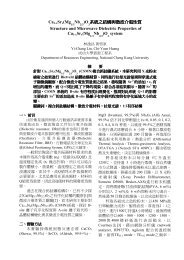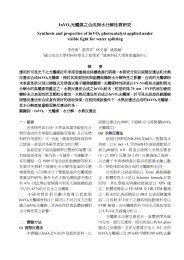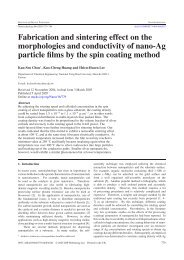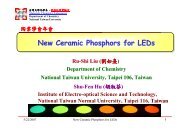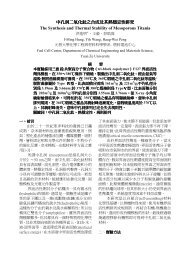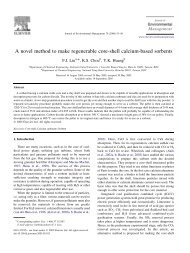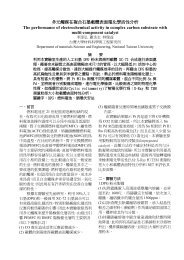Preparation of dense and nano-sized Hydroxyapatite by presureless ...
Preparation of dense and nano-sized Hydroxyapatite by presureless ...
Preparation of dense and nano-sized Hydroxyapatite by presureless ...
You also want an ePaper? Increase the reach of your titles
YUMPU automatically turns print PDFs into web optimized ePapers that Google loves.
for its elimination, see Fig. 3. The reduction <strong>of</strong><br />
agglomeration lowers the sintering temperature<br />
<strong>of</strong> the HAp. See Fig. 4, as the specimens<br />
sintered at 1100 ℃ for 2 hrs, the relative<br />
density <strong>of</strong> the dispersed sample reaches about<br />
90%, but that <strong>of</strong> the die-pressing sample is<br />
below 60%. The reduction <strong>of</strong> agglomerated<br />
size also reduces the grain growth in the final<br />
stage <strong>of</strong> sintering. The grain size <strong>of</strong> the<br />
die-pressing (at 1300 ℃ for 2hrs) <strong>and</strong> the<br />
dispersed specimens (at 1200 ℃ for 2 hrs) with<br />
the similar <strong>dense</strong> microstructures is 2µm <strong>and</strong><br />
0.7µm, respectively. Reducing the<br />
agglomeration <strong>of</strong> fine particles is a prerequisite<br />
for reaching <strong>dense</strong> microstructure without<br />
final-stage grain growth <strong>by</strong> two-step sintering.<br />
In this study, we reduce the agglomerate size<br />
<strong>by</strong> the colloidal process with addition <strong>of</strong> a<br />
dispersant before the formation <strong>of</strong> the HAp<br />
precipitates, that is, before the formation <strong>of</strong> the<br />
agglomerates. Subsequently, two-step sintering<br />
is applied to obtain the <strong>dense</strong> compact without<br />
the final-stage grain growth. The dispersed<br />
specimen after sintering to 1200℃ <strong>and</strong> then<br />
sintering at 1100℃ for 20 hrs displays its<br />
relative density up to 95% <strong>and</strong> grain size 380<br />
nm, see Fig. 5. The specimen increases its<br />
density up to 4% without any grain growth in<br />
the second stage sintering.<br />
Fig. 1. Particle size distributions <strong>of</strong> the HAp<br />
powders treated with various processes.<br />
Fig. 2. Pore size distributions <strong>of</strong> the HAp<br />
specimens prepared <strong>by</strong> various processes.<br />
Fig. 3. Shrinkage rate curves for the HAp<br />
specimens prepared <strong>by</strong> various processes as a<br />
function <strong>of</strong> temperature.<br />
Fig. 4. Grain size <strong>of</strong> the sintered HAp prepared<br />
<strong>by</strong> various processes <strong>and</strong> sintering pr<strong>of</strong>ile as a<br />
function <strong>of</strong> relative density.




